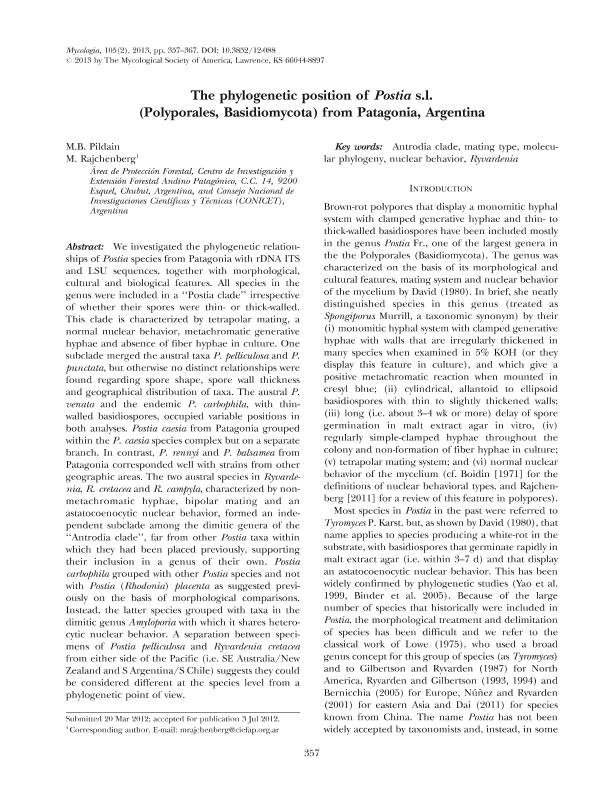Mostrar el registro sencillo del ítem
dc.contributor.author
Pildain, Maria Belen

dc.contributor.author
Rajchenberg, Mario

dc.date.available
2016-01-08T19:49:56Z
dc.date.issued
2012-09
dc.identifier.citation
Pildain, Maria Belen; Rajchenberg, Mario; The phylogenetic position of postia s.l. (polyporales, basidiomycota) from Patagonia, Argentina; Taylor & Francis; Mycologia; 105; 2; 9-2012; 357-367
dc.identifier.issn
0027-5514
dc.identifier.uri
http://hdl.handle.net/11336/3457
dc.description.abstract
We investigated the phylogenetic relationships of Postia species from Patagonia with rDNA ITS and LSU sequences, together with morphological, cultural and biological features. All species in the genus were included in a "Postia clade" irrespective of whether their spores were thin-or thick-walled. This clade is characterized by tetrapolar mating, a normal nuclear behavior, metachromatic generative hyphae and absence of fiber hyphae in culture. One subclade merged the austral taxa P. pelliculosa and P. punctata, but otherwise no distinct relationships were found regarding spore shape, spore wall thickness and geographical distribution of taxa. The austral P. venata and the endemic P. carbophila, with thinwalled basidiospores, occupied variable positions in both analyses. Postia caesia from Patagonia grouped within the P. caesia species complex but on a separate branch. In contrast, P. rennyi and P. balsamea from Patagonia corresponded well with strains from other geographic areas. The two austral species in Ryvardenia, R. cretacea and R. campyla, characterized by nonmetachromatic hyphae, bipolar mating and an astatocoenocytic nuclear behavior, formed an independent subclade among the dimitic genera of the "Antrodia clade", far from other Postia taxa within which they had been placed previously, supporting their inclusion in a genus of their own. Postia carbophila grouped with other Postia species and not with Postia (Rhodonia) placenta as suggested previously on the basis of morphological comparisons. Instead, the latter species grouped with taxa in the dimitic genus Amyloporia with which it shares heterocytic nuclear behavior. A separation between specimens of Postia pelliculosa and Ryvardenia cretacea from either side of the Pacific (i.e. SE Australia/New Zealand and S Argentina/S Chile) suggests they could be considered different at the species level from a phylogenetic point of view.
dc.format
application/pdf
dc.language.iso
eng
dc.publisher
Taylor & Francis

dc.rights
info:eu-repo/semantics/openAccess
dc.rights.uri
https://creativecommons.org/licenses/by-nc-sa/2.5/ar/
dc.subject
ANTRODIA CLADE
dc.subject
MATING TYPE
dc.subject
MOLECULAR PHYLOGENY
dc.subject
NUCLEAR BEHAVIOR
dc.subject
RYVARDENIA
dc.subject.classification
Micología

dc.subject.classification
Ciencias Biológicas

dc.subject.classification
CIENCIAS NATURALES Y EXACTAS

dc.title
The phylogenetic position of postia s.l. (polyporales, basidiomycota) from Patagonia, Argentina
dc.type
info:eu-repo/semantics/article
dc.type
info:ar-repo/semantics/artículo
dc.type
info:eu-repo/semantics/publishedVersion
dc.date.updated
2016-03-30 10:35:44.97925-03
dc.journal.volume
105
dc.journal.number
2
dc.journal.pagination
357-367
dc.journal.pais
Reino Unido

dc.journal.ciudad
Londres
dc.conicet.avisoEditorial
© 2013 by The Mycological Society of America, Lawrence, KS 66044-8897
dc.description.fil
Fil: Pildain, Maria Belen. Centro de Investigación y Extensión Forestal Andino Patagónico, Argentina; Argentina. Consejo Nacional de Investigaciones Científicas y Técnicas. Centro Nacional Patagónico; Argentina
dc.description.fil
Fil: Rajchenberg, Mario. Centro de Investigación y Extensión Forestal Andino Patagónico, Argentina; Argentina. Consejo Nacional de Investigaciones Científicas y Técnicas. Centro Nacional Patagónico; Argentina
dc.journal.title
Mycologia

dc.relation.alternativeid
info:eu-repo/semantics/altIdentifier/url/https://www.tandfonline.com/doi/full/10.3852/12-088
dc.relation.alternativeid
info:eu-repo/semantics/altIdentifier/doi/http://dx.doi.org/10.3852/12-088
Archivos asociados
